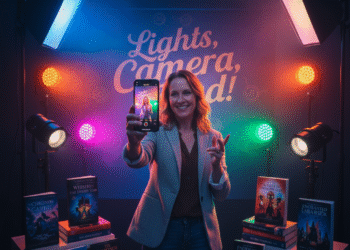Whether you write historical fiction, fantasy, memoir, or self-help, one truth holds for every author: good research makes your book stronger. The world of research is changing rapidly, and the way authors find, verify, and use information is evolving too. By keeping up with the latest research trends, you can make your books more accurate, more original, and more impactful.
In this guide, we’ll explore five research trends every author should know before 2026. We’ll break them down in simple language, with clear examples and tips that you can apply to your own writing, whether you’re building an imaginary world, recreating a historical era, or writing nonfiction to teach and inspire readers.
1. AI-Assisted Discovery: How Current Research Techniques Are Becoming Smarter
Gone are the days of spending endless hours Googling random keywords or flipping through dozens of books hoping to find “that one useful fact.” One of the biggest research trends for authors is using AI-assisted tools to discover information, themes, and connections more efficiently.
What this means for authors
Imagine you’re writing a historical novel set in 1850s Paris. Instead of manually searching through archives one by one, you can use modern tools to map out themes, spot patterns, and find unexpected connections you might have missed on your own.
Or maybe you’re writing nonfiction about creativity. AI tools can help you quickly identify emerging ideas and sources in your field, providing your book with a fresh perspective.
Simple tools to try
- Elicit.org – helps you find answers from academic papers in plain language.
- Litmaps / Connected Papers – visually shows how ideas and sources connect.
- AI chat tools (like ChatGPT) – not as a source themselves, but as a way to brainstorm, find missing angles, or get summaries of topics before you dive into primary sources.
💡 Tip: After drafting your table of contents or chapter summaries, ask an AI tool: “What research areas might I be missing?” You’ll often discover fresh perspectives or forgotten subtopics.
Real example
Suppose you’re planning a memoir about growing up in a rapidly changing city. You might feed your outline into an AI tool, and it could suggest exploring “urban loneliness” or “generational identity shifts”, angles you hadn’t thought of but that make your story richer and more relevant.
This doesn’t mean AI does the research for you; it helps you find better starting points faster. You’re still the creative brain in charge.
2. Open Access & Preprints: Get Ahead of the Curve
A second major research trend is the rise of open access and preprints. In simple terms, this means that more information is now freely available online, often before it appears in books or official journals.
Why this matters for authors
If you’re writing nonfiction, this can give you a competitive edge. Instead of waiting for mainstream media to highlight a new idea or discovery, you can find it at the source, months or even years earlier. Including fresh insights in your book makes it stand out in a crowded market.
For fiction authors, open archives and preprints can help you get the details right. Whether you’re writing about Victorian medicine, AI ethics in 2030, or ancient Egyptian rituals, open access can give you authentic details that make your story feel real.
Where to look
- arXiv.org – great for anything tech, science, or futuristic settings.
- bioRxiv / medRxiv – if you’re touching on health or medical themes.
- DOAJ (Directory of Open Access Journals) – a goldmine of freely available studies across subjects.
- Google Scholar alerts – to get notified when something new appears on a topic you care about.
📌 Note: If you use preprints, always remember they haven’t been peer-reviewed yet. That doesn’t mean they’re useless; it just means you should check multiple sources before treating something as fact.
Real example
Let’s say you’re writing a near-future thriller. You find a preprint from early 2025 about using drones to monitor air pollution in real time. That idea hasn’t yet reached the mainstream, but if you incorporate it into your story, your book will feel visionary when it’s released in 2026.
3. Mixing Data with Real Stories: Research Trends that Connect
Numbers are useful, but stories are what make readers care. A growing research trend is mixing data (facts, statistics, timelines) with narrative research (interviews, personal experiences, anecdotes). This blend gives your writing both credibility and emotional power.
Why this matters for authors
Whether you write fiction or nonfiction, weaving real voices and stories into your research can:
- Add realism to fictional characters and settings
- Make nonfiction arguments more persuasive
- Help you connect with readers on a human level
This approach is especially powerful if you’re writing about communities, experiences, or topics that aren’t widely understood, like neurodivergence, for example. (Our blog on writing neurodivergent characters authentically explores this in depth.)
How to do it
- Interviews: Talk to real people. Record conversations with individuals who have experienced what you’re writing about.
- Surveys & polls: For nonfiction, a simple Google Form can give you data points you can cite.
- Anecdotes: Start a chapter or section with a personal story or case study, then bring in the facts.
✍️ Example: If you’re writing a self-help book about burnout, don’t just say “40% of workers feel exhausted.” Start with one real person’s story of working late nights, then use the statistic to show they’re not alone.
This method doesn’t just make your research stronger; it makes your book memorable.
4. Collaborating with Real People: Participatory Research
This next research trend is especially relevant for authors writing about real communities, cultures, or sensitive topics: collaborative or participatory research.
Traditionally, writers would “research” a group and then tell their story. Increasingly, smart authors are working with communities, not just studying them.
Why this matters
- You avoid stereotypes and inaccuracies.
- Your work earns trust and authenticity.
- People you involve often become enthusiastic supporters of your book.
- You gain insights that you could never find in books or articles.
How to do it as an author
- Invite feedback early. If you’re writing about a particular culture or experience, share your outline or a sample chapter with someone from that community and ask what feels right or wrong.
- Co-create questions. Instead of writing interview questions in isolation, ask a few people what questions they think should be asked.
- Acknowledge contributions. Thank collaborators in your acknowledgments, or mention them in the text if appropriate.
📝 Example: Suppose you’re writing a historical novel set in a small Egyptian village. Instead of relying solely on history books, consider speaking with elders, local historians, or families who still reside there. Their memories and perspectives will bring your story to life in ways no textbook can.
This trend is especially powerful when writing about marginalized groups. It ensures your portrayal is respectful and grounded in real experiences.
5. Staying Organized & Transparent: The “Open Notebook” Habit
The final research trend might not sound glamorous, but it can save you from endless headaches later: keeping a clear research record.
More authors are treating their research process like an open notebook, not necessarily fully public, but well-organized, trackable, and transparent. This doesn’t just help with fact-checking; it builds your credibility as a writer.
Why this matters
- You avoid losing sources and notes.
- You can easily double-check facts before publication.
- If anyone questions your information later, you can show where it came from.
- You save yourself a tremendous amount of time during edits.
How to do it
- Use a reference manager like Zotero, Notion, or even Google Docs to keep track of sources.
- Take dated notes. Whenever you find a source, jot down the date, URL, and a quick summary.
- Keep a simple version log. If your research or outline changes, make a quick note of what and why.
- Back everything up. Cloud storage, external hard drives, whatever works for you.
⚡ Pro tip: Create a “Sources” document for each book, with quick links and summaries. When you get to the editing or marketing stage, this will save you hours.
Pulling It All Together: A Research Workflow for Authors
Here’s a simple way to bring all five research trends into your writing process:
- Start smart: Use AI tools to brainstorm themes and find unique angles.
- Go deeper early: Check open access and preprints to gather fresh, authentic details.
- Blend stories and data: Plan how you’ll use both facts and personal voices.
- Collaborate with people: Reach out to individuals or communities you’re writing about and involve them thoughtfully.
- Keep track of everything: Organize your sources and notes so you can reference them easily.
Future-Proof Your Writing by Adopting Research Trends Today
The publishing world is getting more competitive. Readers have more choices than ever. If your research is shallow or outdated, your book can easily get lost in the noise. But if you embrace these current research techniques and trends — even a few of them — your book will have:
- More original insights
- Richer details and more authentic characters
- A stronger foundation of trust and credibility
- A research process that’s easier, not harder
You don’t have to overhaul your entire writing method overnight. Pick one or two of these research trends and start applying them to your current project. Over time, they’ll become second nature, and your books will shine because of it.









